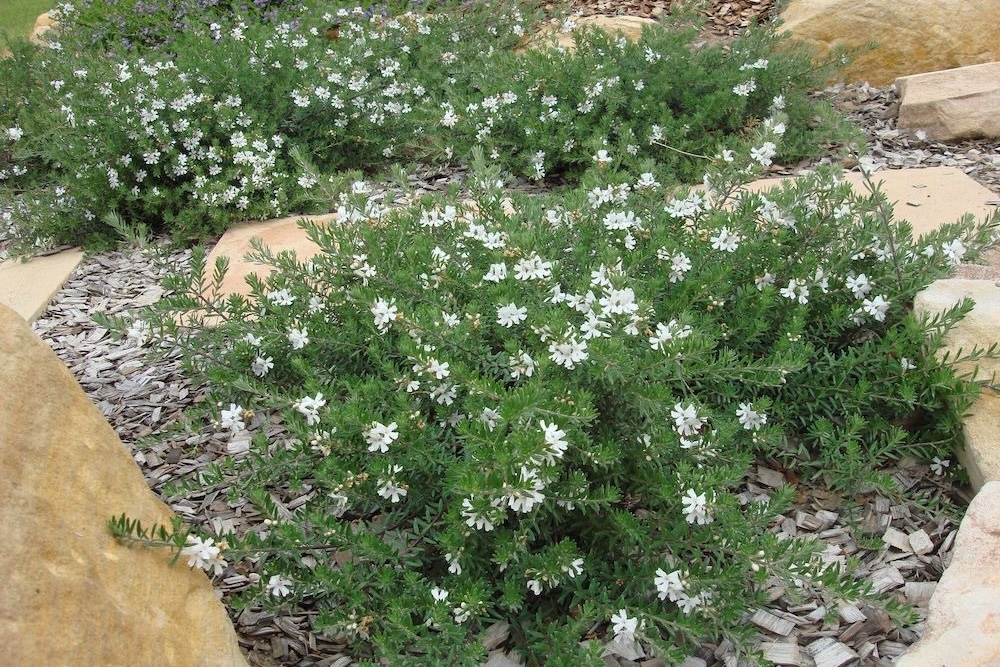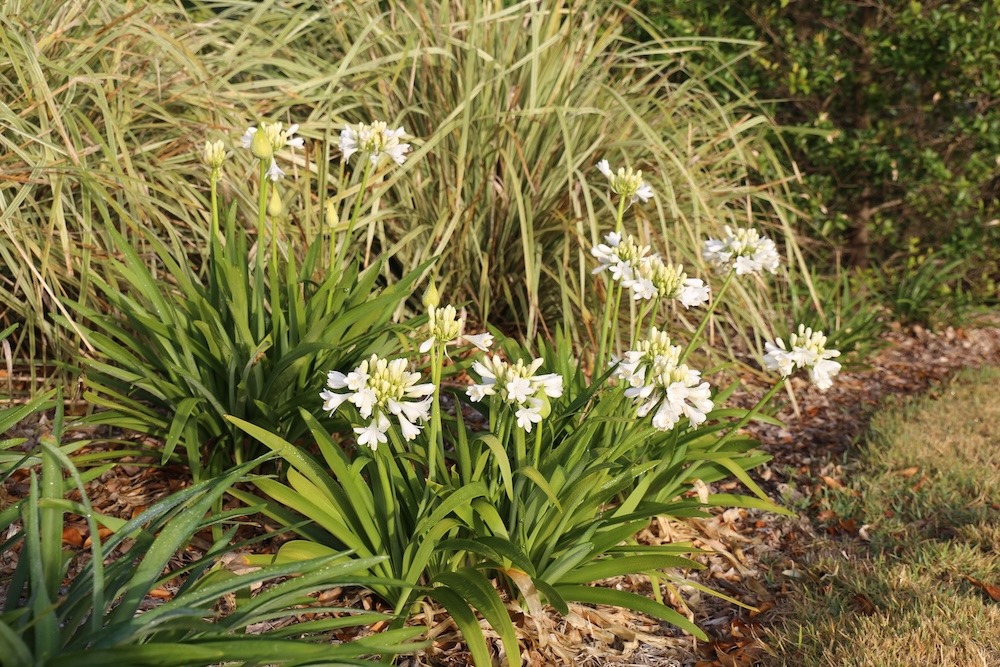Did you know that some of the plants we always thought were native to Australia are actually from Southern Africa?
How to Design Beautiful Agapanthus Combination Plants in Your Garden
The agapanthus plant, also known as African lily, with its striking purple, blue or white flowers and lush green foliage, is a garden favourite. But what can you pair with this hardy perennial for a stunning garden display?
This blog post will guide you on designing beautiful agapanthus combinations in your garden. Towards the middle of the article, we’ll provide a list of plants to help you get started with finding the perfect plants to install along with your agapanthus.

- Understanding Agapanthus
- What Makes a Good Companion Plant?
- Unleashing the Power of Colour, Texture, and Shape to Compliment Agapanthus in the Garden
- Top Companion Plants for Agapanthus
- Designing with Agapanthus: Practical Tips
- Pot Pairings: What Goes Well with Agapanthus in Pots?
- Caring for Your Agapanthus
- Pruning Agapanthus Leaves
- Daniel’s Wrap
Understanding Agapanthus
Agapanthus showcases a clump-forming growth habit, producing lush, strap-like leaves that form an attractive backdrop for the strikingly beautiful flowers held high on upright stems, affectionately called “umbels”.
These perennials typically bloom from late spring through summer, offering a long-lasting display of vibrant colour. They thrive in full sun to partial shade. Although they can tolerate a range of light conditions, they produce the most abundant blooms when exposed to at least six hours of sunlight each day.
Agapanthus prefers moist, well-drained soil. Many varieties are quite adaptable and can thrive in various soil types, including clay, loam, and sandy soils, provided they are well-draining.
What Makes a Good Companion Plant?
Companion planting is a time-honoured gardening practice that pairs plants based on their complementary characteristics and requirements. But what makes a plant an excellent companion for agapanthus?
Plants that share similar light, water, and soil requirements make good companions. This ensures that all plants will thrive under the same care regimen. So if you’re planting directly next to agapanthus, choose a plant that also loves full sun and moist, well-draining soil.
Good companion plants should offer contrasting or complementary colours, textures, or forms to create a visually appealing garden display. For example, the soft, feathery foliage of ornamental grasses contrasts beautifully with the bold leaves of agapanthus.
Companion planting offers numerous benefits beyond aesthetics. It can deter pests, attract beneficial insects, improve soil health, and even enhance the growth of your agapanthus when your plants are working together in harmony.
Unleashing the Power of Colour, Texture, and Shape to Compliment Agapanthus in the Garden
Colour theory isn’t just for artists and interior designers; it’s also a powerful tool in garden design. By understanding how colours interact, you can create stunning visual effects in your garden.

Complementary Colours
Complimentary colours are opposite each other on the colour wheel.
Agapanthus flowers are typically purple, blue or white. Plants with orange flowers (or foliage) like birds of paradise can make the blue blooms of agapanthus stand out. Meanwhile, yellow flowers such as billy buttons can compliment purple agapanthus blooms.
Monochromatic Schemes
A monochromatic colour scheme uses different shades and tints of a single colour. You could create a calming, cohesive look by pairing blue agapanthus with other blue or purple flowers like lavender or certain varieties of salvia.
Analogous Colours
Analogous colours originate from the same section of the colour wheel. You can create a harmonious and soothing palette when combining shades like indigo, violet, and blue found in the foliage, flowers and berries of certain dianella varieties.
Warm and Cool Colours
Warm colours, encompassing reds, oranges, and yellows, exude vibrancy and evoke a sense of energy. Interweaving these warm hues amidst the agapanthus can infuse dynamism and draw attention to focal points within the garden.
Yellow buttons and grevilleas fit the bill here. On the other hand, cool colours like blues and purples bestow a tranquil ambiance, evoking a sense of calmness. Again, lavender and dianella can provide the cool colours you need.
Texture and Shape
Beyond colour, texture and shape also play crucial roles in garden design. They add depth and interest and can significantly influence the mood of a garden.
Agapanthus has bold, strap-like leaves and globular flower heads. Plants with contrasting textures, like the feathery foliage of ornamental grasses or the needle-like leaves of rosemary, can enhance the visual impact of agapanthus.
Combining plants with different shapes can create a dynamic, balanced garden. The upright clumping form of agapanthus pairs well with mounding plants like lavender, or sprawling ones like creeping thyme.
Tropical Theme in Temperate Climates
Gardeners in cooler parts of Australia, like parts of Victoria, NSW, Tasmania, South Australia and the bottom of WA, can use agapanthus to help achieve a tropical look to their gardens, along with other tropical-looking plants that don’t necessarily need tropical conditions to look their best. This includes birds of paradise and certain Ficus species.
Top Companion Plants for Agapanthus
Choosing the right companions for agapanthus can help you create a diverse, visually stunning garden. Here are some popular choices that pair well with agapanthus.
Roses
Roses share similar growing requirements with agapanthus, making them a natural pairing. The show-stopping blooms of roses contrast beautifully with the simple elegance of agapanthus flowers. Their combined display is truly breathtaking.
Lavender
Lavender’s silvery-green foliage offers a contrast to the strappy green leaves of agapanthus, while their fragrant purple or white flowers pair well with the bold purple, blue or white blossoms of agapanthus. Both plants enjoy full sun and well-drained soil, making them easy to grow together.
Westringia
An Australian native shrub, westringia can play a similar role to lavender because it’s a woody shrub perfect for hedging. Instead of purple flower spikes rising above the plant, westringias have white, blue or purple flowers throughout the whole plant, offering a monochromatic or analogous cool colour pairing for agapanthus.

Ornamental Grasses
Ornamental grasses, such as Pennisetum and Poa varieties, add texture and movement to a garden. Their fine foliage balances the robust structure of agapanthus, creating an interesting dynamic.

Ground Covers
Instead of boring mulch, (or even worse, bare soil) surround your agapanthus with some flowering ground covers. Gazanias are also native to South Africa, and they love full sun and well-drained soil, so they’re a natural fit for pairing with agapanthus.
Just beware that some varieties are incredibly weedy, so pick a variety that’s sterile such as Double Gold™ Gazania.

Edible Herbs
Edible herbs can play a ground-covering role with the added benefit of being nutritious and delicious. Whether you’re planting into a pot or directly into the ground, herbs like oregano, thyme, prostrate varieties of rosemary and other herbs are perfect companions for your agapanthus.

Designing with Agapanthus: Practical Tips
Armed with a list of potential companions, we’ll now give practical tips on designing a garden around agapanthus.
Correct spacing between your agapanthus and their companion plants is crucial for healthy growth. It prevents overcrowding, allows for adequate air circulation, and ensures each plant receives enough light. While it’s in fashion to have plants growing wild, you need to understand the genetic destiny of each plant.
For example, while you can allow the ground-covering herbs to grow right up against the agapanthus base, you might want to prune them when they start climbing your aggie. And you can allow your salvia flowers to gracefully touch the agapanthus foliage, but planting them too close can cause competition for resources and start to look messy (not in a good way).
Create a tiered effect in your garden by planting the tallest plants at the back, medium-height plants in the middle, and the shortest plants at the front. This will ensure every plant is visible and appreciated.
Pot Pairings: What Goes Well with Agapanthus in Pots?
If you’re working with limited space, agapanthus can thrive in pots. Herbs like rosemary, oregano and thyme make great pot companions due to their similar light and water requirements. Ground-covering herbs look amazing when you let them cascade over the edge of the pot, beneath the strappy agapanthus leaves that will also cascade over the edges.
In larger pots, you can add an additional layer of a taller plant in the middle of some dwarfed agapanthus plants and ground-covering herbs, such as an ornamental fig. You can arrange multiple potted displays at different heights for maximum impact. Use differently-sized pots, stands or shelves to achieve this layered look.
Caring for Your Agapanthus
Agapanthus plants are relatively easy to care for. They prefer the soil to stay moist without being wet, but can tolerate dry or wet feet for short periods of time.
While they do just fine without much fertilisation, a good slow-release fertiliser, especially an organic one, in late winter or early spring will help them produce abundant blooms. Once the flowers have died, cut the dead heads back to the base to encourage another flush of flowers.
Over the years, they may outgrow the space with vigorous rhizomes, at which point you can divide the plants at the base to reduce the amount of plants. You can then plant the excess plants, or simply throw them into the compost bin.
You should know that plants that hold plant breeder’s rights (PBR) cannot be propagated if they are intended for sale.
They can only be propagated for personal use. Nurseries nurture these using specialised methods, often via tissue culture, and it’s at times simpler or more cost-effective based on your time to obtain them. Nevertheless, if you have the time and are not vending them, it could be worthwhile to perform the propagation yourself.
Pruning Agapanthus Leaves
Some people like to prune agapanthus leaves, and they can tolerate this. However, it’s unnecessary when you have the right plant in the right place, and it almost seems disrespectful to the plant’s natural habit. At least, it does to me, anyway.
Removing dead leaves at the base of the plant helps your agapanthus look its best.
If you’d like to learn more about caring for your agapanthus plants, read this article. (My article about maintaining agapanthus plants)

Daniel’s Wrap
Designing beautiful agapanthus combinations in your garden is an art, as well as a science. With a clear understanding of this plant’s needs and characteristics, and the right choice of companions, you can create a visually appealing and thriving garden.
Start experimenting today and watch your garden transform into a stunning oasis.




This Post Has 0 Comments